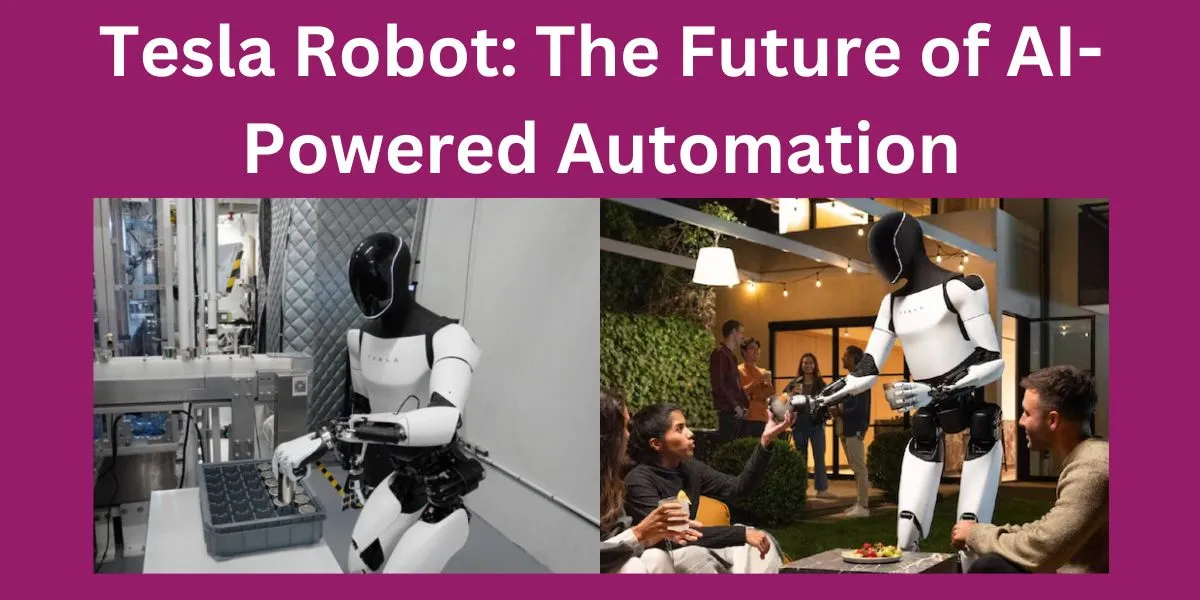In recent years, Tesla has been pushing boundaries in the automotive industry, renewable energy, and now, robotics. The introduction of the Tesla Robot, also known as Optimus, marks a significant leap into the future of AI-powered automation. While Tesla is known for its electric vehicles and autonomous driving, this robot is a whole new ball game. But what exactly is it? Is it worth the hype? And how will it impact our daily lives? Let’s dive in and explore everything you need to know about the Tesla Robot.
What Is The Tesla Robot?
The Tesla Robot, codenamed Optimus, is an advanced humanoid robot that Tesla announced in 2021. Elon Musk, Tesla’s CEO, stated that the robot is designed to perform mundane, repetitive, and dangerous tasks. Unlike other robots that are bulky and have limited functionality, Optimus is sleek, humanoid, and powered by Tesla’s AI—the same technology used in their self-driving cars. But what sets it apart is its potential to be a fully functioning companion that can do more than just factory work.
Key Features of the Tesla Robot
- Height and Weight: Optimus stands at 5’8″ and weighs 125 pounds, making it similar in stature to an average human.
- Speed: It can move at a speed of up to 5 miles per hour, ensuring that it can perform tasks at a pace comparable to human workers.
- Lifting Capacity: The robot is capable of lifting up to 150 pounds, with a deadlift capacity of 45 pounds in each hand.
- AI Integration: Tesla’s AI technology powers its decision-making and mobility, allowing it to navigate environments autonomously.
How Does the Tesla Robot Work?
The Tesla Robot is powered by Tesla’s Full Self-Driving (FSD) AI—a complex neural network that processes large amounts of data in real-time. It uses the same sensors and cameras as Tesla cars, which means it can recognize objects, navigate obstacles, and understand its environment. Additionally, the robot is equipped with autopilot cameras, artificial intelligence, and actuators that give it human-like movement.
One of its most intriguing features is the ability to learn and improve over time. Just like Tesla vehicles can receive over-the-air updates to improve their performance, Optimus will also benefit from continuous software improvements.
What Can The Tesla Robot Do?
The Tesla Robot is designed to handle tasks that are either boring, repetitive, or potentially dangerous. Think about all the monotonous jobs we do every day—taking out the trash, cleaning the house, or assembling products in a factory. Optimus is built to tackle those tasks for you.
Household Tasks
Imagine having a personal assistant that never needs a break, never complains, and doesn’t forget what you asked them to do. The Tesla Robot could take over daily chores like cleaning, grocery shopping, and even cooking meals. In the future, we could be looking at a world where household robots take care of every mundane task, leaving us with more free time.
Industrial Applications
The industrial sector will likely see the biggest immediate impact from the Tesla Robot. With its ability to lift heavy objects and handle repetitive tasks, Optimus could revolutionize industries like manufacturing, construction, and logistics. Factories could become fully automated, with robots working side by side to streamline production.
Hazardous Jobs
One of the most important uses for Tesla’s Robot is in hazardous work environments. Think of jobs like mining, deep-sea exploration, and disaster relief. These are jobs that put human lives at risk. Optimus could take on these dangerous roles, minimizing risks while improving efficiency.
Why Is Tesla Making Robots?
Tesla’s mission has always been to accelerate the world’s transition to sustainable energy, but Elon Musk has also made it clear that AI and robotics will play a key role in the future of human civilization. The goal of creating the Tesla Robot is to address labor shortages, improve workplace safety, and enhance productivity.
Musk believes that by automating the most mundane and dangerous tasks, we can free up human time for more creative and meaningful work. He’s also hinted that robots like Optimus could help us deal with an aging population by taking over care and support roles for the elderly.
How Is the Tesla Robot Different from Other Robots?
There are plenty of robots out there, so what makes Optimus stand out? First, its integration with Tesla’s AI gives it a significant advantage in terms of mobility and decision-making. Most robots can perform a few specialized tasks, but the Tesla Robot has the potential to learn and adapt over time.
Humanoid Design
Another differentiating factor is its humanoid form. While many robots are designed for industrial purposes and have functional, albeit non-human, designs, Tesla has gone the extra mile to make Optimus look and act more like a human. This could have huge implications for how robots integrate into society, making them more relatable and less intimidating.
Continuous Improvement
Tesla’s robots, much like their cars, will benefit from software updates that continuously improve their abilities. Other robots might require physical modifications to upgrade, but Optimus will simply need a software update to enhance its capabilities.
Potential Impact on Society
The introduction of the Tesla Robot has sparked discussions about how this level of automation will impact society. While the robot could bring about incredible improvements in productivity and efficiency, it also raises questions about job displacement and income inequality. After all, if robots can do everything humans can, what happens to those jobs?
Job Automation
On one hand, robots like Optimus could replace humans in jobs that are dangerous or tedious, improving overall workplace safety. On the other hand, it could lead to job displacement in industries like manufacturing and logistics, where automation is already a growing trend.
A New Era of AI-Powered Labor
While some fear job loss, others see the Tesla Robot as ushering in a new era of AI-powered labor. Rather than eliminating jobs, Optimus could create opportunities in robotics maintenance, AI development, and robot-human collaboration. Imagine a future where robots and humans work hand-in-hand to achieve higher productivity.
Ethical Considerations
As with any major technological advancement, the Tesla Robot comes with its own set of ethical challenges. One of the biggest concerns is AI safety. Will robots like Optimus be able to make ethical decisions, or could they be prone to glitches and malfunctions that put humans at risk?
Another concern is data privacy. Tesla’s cars already collect data about their surroundings, and it’s reasonable to assume that robots like Optimus will do the same. This raises questions about how that data will be used and whether it could be exploited.
The Future of Tesla Robots
The potential for the Tesla Robot is enormous. While it’s still in the early stages of development, the implications for society, industry, and everyday life are clear. Whether it’s helping with household chores or working in hazardous environments, the Tesla Robot could be a game-changer. And with Tesla’s focus on continuous improvement, who knows what future versions of Optimus will be capable of?
Expanding Beyond Earth
Elon Musk has always been vocal about his ambitions to make humanity a multi-planetary species. Robots like Optimus could play a vital role in colonizing Mars or other planets, handling dangerous tasks like building habitats or mining resources. This could be just the beginning of Tesla’s journey into space robotics.
Conclusion
The Tesla Robot is an exciting leap into the future of AI and robotics. With its ability to handle both mundane and hazardous tasks, it has the potential to revolutionize industries, improve safety, and even become a part of our everyday lives. However, with great power comes great responsibility, and there are still many questions to answer about its ethical implications and societal impact. One thing is for sure—Tesla is once again pushing the boundaries of what technology can achieve.
FAQs
1. When will the Tesla Robot be available?
Tesla has not provided an official release date, but early prototypes are expected in the coming years, with wider availability potentially by the end of the decade.
2. How much will the Tesla Robot cost?
Tesla has not yet disclosed pricing information, but considering the technology involved, it’s likely to be quite expensive in the beginning, possibly in the range of several thousand dollars.
3. Can the Tesla Robot replace humans in the workplace?
The Tesla Robot is designed to handle repetitive and dangerous tasks. While it may replace some jobs, it is also expected to create new opportunities in AI development and robot maintenance.
4. Is the Tesla Robot safe to use around humans?
Tesla is developing the robot with safety in mind. It will be equipped with advanced AI to prevent accidents and operate safely in human environments.
5. Can I buy a Tesla Robot for personal use?
In the future, Tesla hopes to make the robot available for both industrial and personal use, though early models will likely be targeted at industries needing automation.










